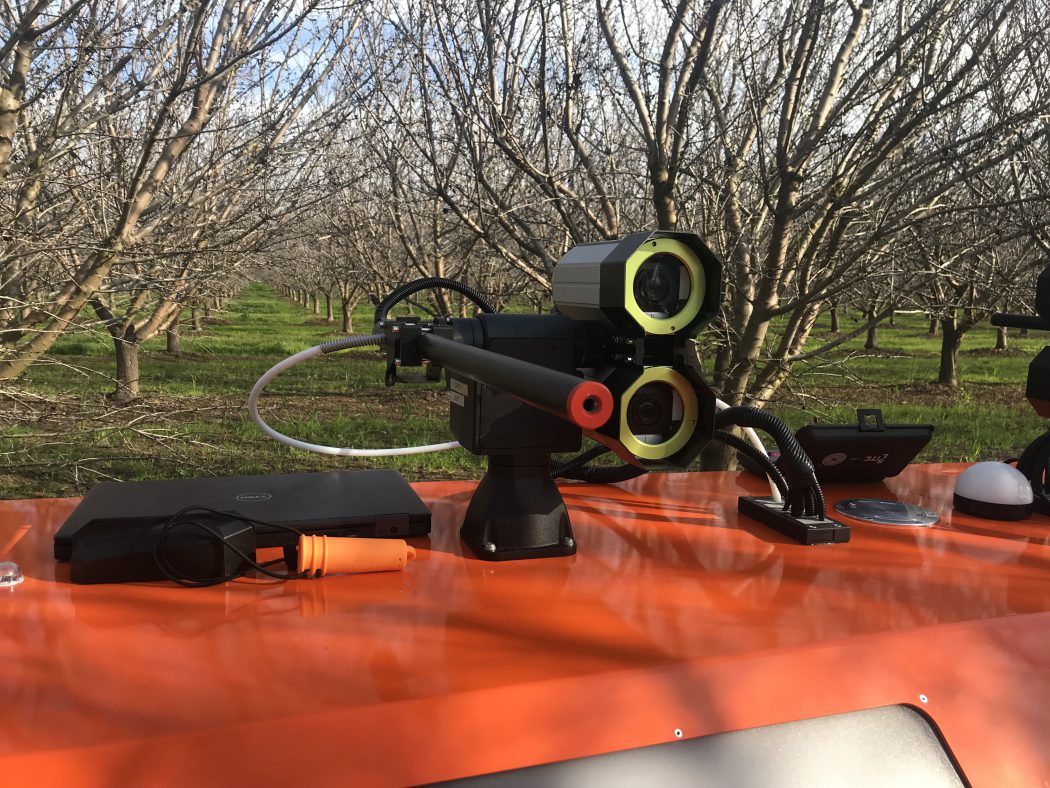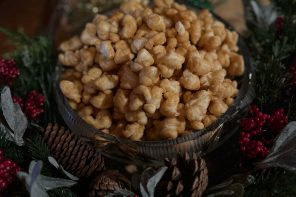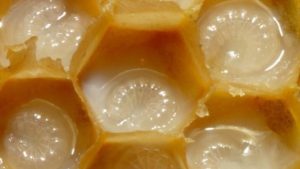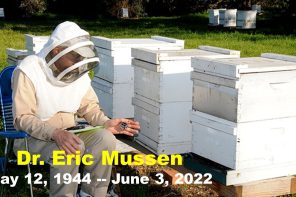The Future of Commercial Beekeeping
By: John Miller
Many years ago, a futurist/motivational speaker named Ed Barlow spoke to the National Honey Board. I was an Alternate Member, Producer Region three at the time; but was fortunate enough to hear the presentation. His remark, ‘The future won’t necessarily be bad. It will be different.’ Stays with me to this day. Since the late 1980’s the future has not necessarily been bad or good. We can spend pages and pages on our opinions of the future. Change is constant.
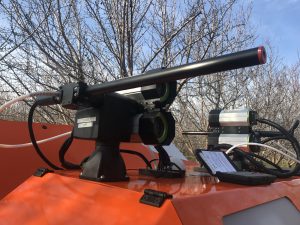
Pictured is a new device in use at Bullseye Farms, near Woodland, CA. The InsightTrac device cameras tri-angulate, while trolling through an almond orchard on tracks – ‘looking’ for stick-tights. Stick-tights are almonds in the shell, that refuse to release from the tree when shaken, during harvest. Stick-tights are an almond grower’s affliction. That big, long, orange-tipped barrel fires a pellet at stick-tights. Why? Stick-tights harbor Navel Orange Worm [NOW]. NOW’s set up housekeeping in stick-tights, raise a family that in the Spring spread throughout the orchard. Growers face dockage when NOW infest harvested nuts. Walnut growers also fight NOW.
Beekeepers are interested in models SL-100 & SL-150 Mag Laser Boresighting System. It’s the future.
An almond grower seeks to maximize crop quality and minimize crop dockage. After harvest, stick-tights represent a hygienic cost to the grower. A grower may elect to chemically control NOW with a pesticide application – an increasingly expensive and difficult process in California. She may hire a ‘polling crew’ of perhaps dozens of employees walking through the orchard with 20 foot poles, physically knocking the stick-tights from branches; or may employ a device like the Mag Laser System. None of the solutions are cheap. Orchard hygiene is now a leading almond orchard expense.
In the recent past, a designer and inventor, Anna Haldewang mused on the challenge of stick-tights. She was visiting Mel Machado’s [Blue Diamond Grower Relations] office in Ripon, CA. A prototype device was assembled. It was big, ugly, buggy [in a techy way], and temperamental. V 2.0 was better. Over 20,000 images of almond trees, tree rows, stick-tights, branches, scaffolds, and an occasional blackbird were logged into the ‘training’ of the device.
The skeptical approach challenges ideas and inspiration. ‘I don’t know if this thing is going to work’. A lot of stuff does not work. Everyone has a brilliant idea that will not work. Creating the future isn’t simple, and it isn’t cheap – and sometimes does not work.
About twelve years ago, at Miller Honey, we came up with a contraption to mechanize dividing hives. It was a terrible thing. It was fast, and brutal. It was featured in a documentary called More Than Honey, by Marcus Imhoof. I’m not proud of the device.
Beekeepers invest a lot of labor and expense making up Spring divides. It’s how we sustain an unsustainable hive count.
In the future, a device will mechanize hive divisions.
200 parent hives present, on pallets; and are placed on a conveyance.
Hives will enter the process and scanners, cameras, lasers, and chemical sensors – all with 20,000 images of learned observation will ‘work the hive’. Instead of a hive tool, smoke, muscle strength, sweat-strained eyesight, experience and subjective analysis – hives will pass across a conveyance.
During conveyance, hives will be disassembled with the smooth precision of mechanical handling. Levers will dislodge frames without dislodging bees. Scanners will evaluate frames; brood coverage, stage of brood development, resources; including pollen, and stores of honey. Chemical sensors will identify brood diseases [if any] and appropriately segregate or pass on frames. Lasers will scan for the Queen – dispatching her; so every single nucleus will be receptive to a replacement Queen. Phoretic Varroa and Tropilaelips will be laser dispatched. Chemical sensors will document presence and abundance of mites. The physical well-being of frames will be analyzed, removed, replaced, or repositioned to optimal placement, based on 20,000 learned images of broken ears, end bars, bottom bars, mouse damage and cell structure.
‘Nucs’ will be assembled, with the precise amount of brood, bees, feed, pollen, filler frames, feeder [filled] in positions one to nine occupy the hive body. Nine day-old Queen cells will be placed securely in the optimal position. [Mated Queens with perfectly punctured candy face down are an option.] Nucs will be fitted onto a pallet, cover correctly placed, and gently stacked four pallets high; one atop the other, and conveyed to the loading site. An automated forklift removes completed stacks.
The operator receives the output data. 2.3 net nucs per parent hive were harvested from 200 parents. Process analytics provides relevant data of disease, pestilence, and wellbeing.
The process occurs daily, every day, rain or shine – for 30 days, without interruption.
The process occurs indoors. The indoor storage building optimizing the wintering experience for hives now fulfills a second vital commercial beekeeping activity. The building is dark. The climate is controlled. The concrete is smooth, clean and never tips a stack. The harrowing labor intense dividing experience is replaced. The building houses replacement hive bodes, new frames, pallets, feeders, cell incubators, the necessary hardware is indoors, accessible, dry, in good repair, automatically inventoried, and replenished. The equipment is standard, universal, interchangeable. Syrup is held in a single tank, a single pump, measured, unspilled.
For inspiration, tour a distribution center. I don’t know who will make this work – but it will.
Designers and inventors like Anna Haldewang are inspiring. A young generation of beekeepers are going to make this work. ‘The future won’t necessarily be bad. It will be different.’
JRM






